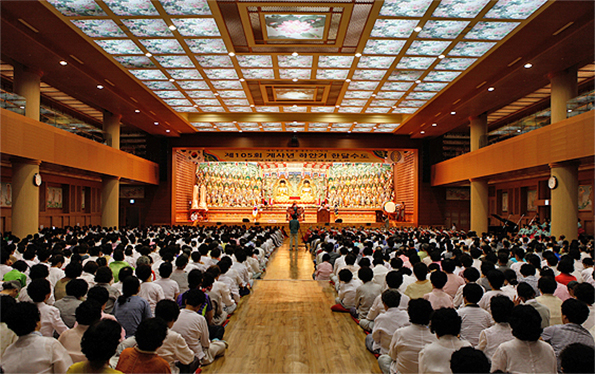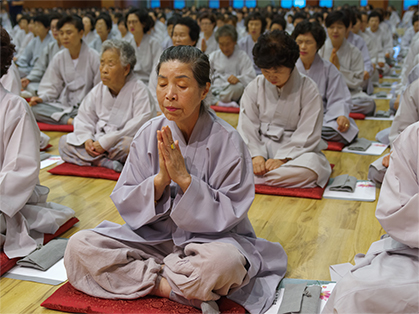Daegwangsa

- The spirit of practicing asceticism strictly became the foundation
that Tiantai Buddhism could rapidly grow in Korean society.
One of the remarkable characteristics of Tiantai Buddhism asceticism is Vassa that the four classes of the persons who follow participate together.
The spirit of practicing asceticism strictly became the foundation
that Tiantai Buddhism could rapidly grow in Korean society.
One of the remarkable characteristics of Tiantai Buddhism asceticism
is Vassa that the four classes of the persons who follow participate together.
The persons who became Buddhist monks and practiced asceticism based
on nonpossession and religious mendicancy when Buddha lived practiced
asceticism
settling and staying at one place for three months due to the climate
characteristics that it continued to rain. This became current Vassa.
Generally, the main agents who did vassa were the persons who became
Buddhist monks and the persons who cultivate themselves morally or
religiously just stayed at the role to help them finish Vassa safely.

However, in Chontae Order of Korean Buddhism, the persons who cultivate themselves morally or religiously as well as the persons who became Buddhist monks can participate in Vassa. Rather, the role of the persons who cultivate themselves morally or religiously is important during the Vassa period as it is difficult to tell about it except them. Because the persons who cultivate themselves morally or religiously can be the main agents of Vassa by themselves, the place for innovative asceticism was prepared.
More than 1,000 believers who cultivate themselves morally or religiously have participated in Vasse in Guinsa Temple for a month each time. They have continued the tradition of farming by day and practicing asceticism by night and done many things as well as the public offerings.
In the Vassa period, the monks responsible for it lead Vassa asceticism by reading Buddhist writings at the time appointed everyday for guidance of the believers who cultivate themselves morally or religiously and encouraging them to do Avalokitesvara Bodhisattva.
Monks' Vassa is implemented for about 2 months after Winter Vassa of
the believers who cultivate themselves morally or religiously ends.
The monks devote themselves in Sambodang from 8:00 p.m. to 6:00 a.m.
every day after stopping all their duties during the Vassa period.
Tiantai Buddhism's Vassa is simultaneously implemented in
Tiantai Buddhism temples all over the country for a month two times per year.
It is essential for the believers who cultivate themselves morally or religiously
to participate in it. Vassa that has held in Guinsa Temple, the headquarter, every year
has already been implemented more than 100 times. Everybody can participate in Vassa even
in regional temples all over the country. It makes it a rule to stay in temples for 24 hours
and the believers must not go out of mountain temples. But it has been arranged to make you
do it without problems while they work and keep house. They fulfill their duties at the workplace
and in their houses during the daytime and devote themselves to do Avalokitesvara Bodhisattva from
10:00 p.m. to 4:00 a.m. It means that believers practice farming by day and practicing asceticism
by night. When Vassa begins, the ceremony for beginning the meditation retreat season is held so
that aspiration for Buddhahood is created. When it ends, the ceremony for closing the three month
intensive summer and winter meditation retreats is done so that acts of charity can return to the
entire universe. And believers listen to Great monk's Buddhist writings once per week and have time
to make their mind constant.
It is asceticism that the teachings and practice become
one and 교관 is combined.








